Made in Slovenia
STA, 5 March 2019 - Ivo Štandeker, a Slovenian journalist killed while reporting from besieged Sarajevo at the start of the war in Bosnia in 1992, will be posthumously honoured by the city of Sarajevo with the Citation of the City of Sarajevo.
The Citation is conferred on Bosnian or foreign citizens, companies and organisations for their contribution to Sarajevo's development in a number of fields.
Štandeker is considered one of the finest and most critical Slovenian reporters from the 1990s.
He was wounded during the Serb shelling of the Sarajevo borough of Dobrinja on 16 June 1992 and died a few hours later in a hospital in Pale.
Also wounded alongside Štandeker was US photojournalist Jane Schneider, with whom he had wanted to get to a spot from where they could take photos of a nearby hill where the Serb troops were stationed.
A decision to honour Štandeker (1961-1992), war correspondent for the magazine Mladina, has been taken by the city council, a Slovenian association from Sarajevo said on its Facebook page.
A memorial plaque to Štandeker was unveiled at the site where he was wounded in 1997, and he was also posthumously honoured in 1992 with the Order of Freedom, the highest state decoration in Slovenia.
The Slovenian Cultural Society Cankar in Sarajevo said that in his reports from the besieged city, Štandeker sympathised with the locals.
It quoted his statement "I love cities and I hate it if they get attacked", which is inscribed on the memorial plaque.
During the 1990s wars in the former Yugoslavia, Štandeker also reported from the besieged Croatian cities of Vukovar and Dubrovnik.
The screenshot at the top of this story comes from this Slovenian video
While other firms that make products related to bathroom concerns may like to use a lateral approach when discussing the merits of their goods, such as the soft and fluffy puppies that have been used to promote a certain brand of toilet paper in the UK for decades, Donat Mg is upfront and unashamed about the benefits that drinking its mineral water will bring to consumers.
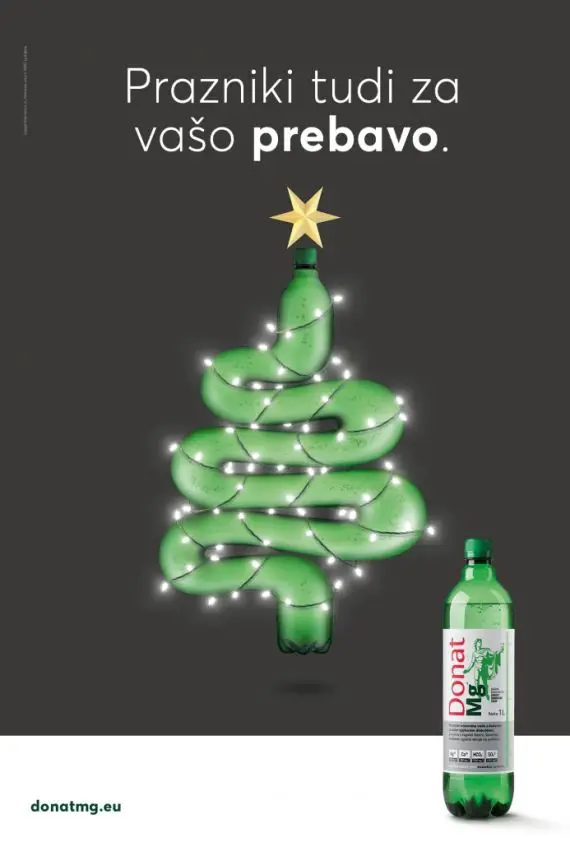
"Also a holiday for your digestion" Photo: donatmg.eu
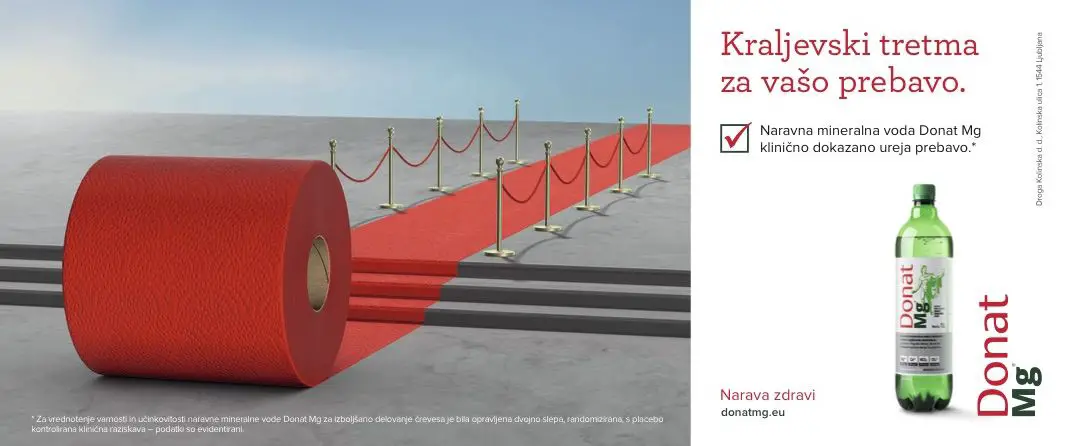
"The royal treatment for your digestion" donatmg.eu
They will poop, more easily and with pleasure, thus relieving constipation and discomfort. What’s more, the firm has a tradition of award-winning advertisements that confront the issue head on, giving the brand a strong identity that’s loud, proud and arresting, with one of the more sophisticated campaigns that we’ve seen in Slovenia.
The water comes from the springs of Rogaška Slatina, which have been known of since Roman times and used for spa treatments since at least the 17th century, although the spring which provides the water from Donat Mg was only discovered in 1908.
The drink works its digestive magic due to the sulphate salts it contains, which give the water the property of hyperosmolarity, and thus it's a natural osmotic laxative. As noted on the brand’s website:
Its effectiveness as a laxative is due to sulphate salts (magnesium sulphate or Epsom salt and sodium sulphate or Glauber’s salt) and around 1000 mg/l of magnesium. Sulphates draw water from the cells of the intestinal wall by osmosis, increasing the volume of intestinal content 3 to 5 times; this exerts pressure on the intestinal wall and triggers its peristalsis or movement. Magnesium also additionally stimulates the intestinal hormones that boost peristalsis.
Consumers are thus advised to treat Donat Mg with some respect, and to take care not to drink a bottle or three when simple sparkling water, such as the similarly packaged Radenska, is desired. While the bottom won’t fall out of your world if you make such a mistake, the world might fall out of your bottom.
Related: Slovenian brands - Radenska (videos)
STA, 13 February 2019 - The Slovenian start-up PlanetCare has developed filters specifically designed to catch microfibres shed from textiles and clothes during washing and drying.
Since every load of laundry produces a large amount of microfibers that end up in the food chain and pose a threat to animals and humans, PlanetCare has designed filters for washing machines to remove these microparticles.
For now, the start-up focuses primarily on end-users, creating a range of add-on filters for existing washing machines, while also negotiating with home appliance manufacturers to install built-in filters. Their latest innovation is an industrial filter for larger laundry facilities.
According to PlanetCare, their filters were tested by leading research institutions with results confirming the filters successfully remove a significant quantity of microfibres.
Last week, the start-up presented their product at the international trade fair ISPO Munich. They took part in a group study on microplastics where they showed how to turn plastic waste into raw material by first grinding it and then using a 3D printer to transform the waste into a PlanetCare microplastic filter.
Since last year, PlanetCare, Sympatex Technologies, the Plastic Soup Foundation, the Plastic Leak Project initiative and the Italian Institute for Polymers, Composites and Biomaterials have been working on a study examining Sympatex's materials to find the most effective way to reduce the amount of microfibres in washing machine waste water.
You can learn more about PlanetCare at the company’s website
STA, 13 February 2019 - A child of the ironworks that started appearing in the Pohorje hills in north-eastern of Slovenia as far back as the 18th century, forged metals and toolmaker Unior is looking back at its 100 years in 2019. Unior, whose workforce has climbed to 3,700, seems here to stay, having developed into a leading global supplier for the auto industry.
The company, originally named Styria Iron Works Company Ltd., started in 1919 as a forge in Zreče. Before World War II, it had 250 workers, who manufactured hand tools for farming, forestry and different crafts.
While the original facilities were burnt down in the war, they were rebuilt immediately after. The plant was renamed Factory of Forged Tools Zreče and passed into "state" or public ownership in 1950, remaining under indirect state ownership to this very day.
Production soon expanded to drop-forged parts, which asserted themselves in the auto industry, while operations also followed political dictate, meaning the most pressing needs of the joint country of Yugoslavia - forged tools, i.e. sockets, all types of vices, adjustable spanners, pliers, forged parts for cars, bicycles etc.
The company's current name Unior, an amalgamation of the words univerzalno orodje (universal tools), came after a 1968 worker strike that was followed by receivership and a fresh start.
By 1978, Unior asserted itself as an important partner of the automotive industry, becoming a major European manufacturer of light forgings and one of the largest European manufacturers of connecting rods for petrol engines, which positioned it among the major suppliers for companies like VW, BMW, etc.
In the same year, the company started developing and manufacturing special machines for metal processing, while construction notably also began of the Rogla health resort and sports centre and the Terme Zreče spa.
Exports of hand tools were pushed in the mid-1980s though a worldwide distribution network, which would prove crucial after the loss of Yugoslav markets in 1991.
Having braved the bumpy transition, Unior became a joint-stock company in 1997, acquired a stake in Slovenian steel producer Štore Steel a year later, and set up Ningbo Unior Forging in Yuyao, China, in 2005.
A major blow came with the crisis in 2009, which necessitated a number of measures, including a capital increase of tens of millions of euro and the promise to banks to sell the tourism division.
Plans to privatise the company also emerged but have quieted down, and Unior has been going strong after emerging from the crisis.
CEO Darko Hrastnik told the STA that Unior estimates to have generated a record EUR 165m in revenue in 2018 at the level of the core company, which employs 1,800 people.
Hrastnik expects a slight slowdown due to global trends but not a recession, with the company planning to preserve an annual growth rate of 3%-5% also in the coming years.
He highlighted Unior's connecting rods and forgings for car steering mechanisms, saying that order contracts are being signed for five to seven years in advance.
While already present, in particular with its hand tools, in over 100 countries, Hrastnik announced an additional expansion in the coming four years.
"While it was still true 20 years ago that we couldn't sell forgings to other continents, we're now also marketing our products in North and South America. If the financial resources allow, we'll continue to develop production on the American market," he said.
As the global sale of traditional hand tools is stagnating, Unior has taken on new projects, such as bicycle tools and tools for working at high voltage.
Hrastnik said that debt reduction is progressing smoothly and announced that the tourism division, which was spun off into a new company called Unitour in 2017, would likely be sold this year.
The executive said there was little news regarding attempts to privatise Unior - the last one was halted in 2017, and argued that while this created some uncertainty, it did not impact day-to-day operations.
In case a sale occurs, Unior would wish for a strategic owner, which however also allows for several scenarios given the diversity of its divisions.
"Whoever would wish to buy Unior today would buy it with all its metal programmes which do have a lot of synergy, but perhaps still not enough for some," said Hrastnik.
However, even if there is no change to ownership, which involves a number of shareholders with different interests, Hrastnik expects continuing growth or even more.
He spoke of preliminary plans to enter aluminium forging, which would mean a fourth metal division for the company and involve the potential for very fast growth.
STA, 8 February 2019 - Slovenia is observing Culture Day on Friday, a bank holiday dedicated to artists and their work. While virtually every town will hold at least a small ceremony, President Borut Pahor will honour writer Florjan Lipuš, a member of the Slovenian minority in Austria, with the Golden Order of Service for his contribution to literature.
However, the main event already took place, as the Prešeren Prizes, top national accolades in arts and culture, were given out last night.
Two lifetime achievement prizes were given out this year, going to theatre costume designer Bjanka Adžić Ursulov and independent documentary director Filip Robar Dorin.
The Prešeren Fund also gave out six prizes for exceptional artistic work over the course of the past three years. These went to choir conductor Martina Batič, composer Tomaž Svete, poet Jure Jakob, actor Maruša Majer, animated film maker Dušan Kastelic and architects Aljoša Dekleva and Tina Gregorič Dekleva.
The award ceremony is usually a topical affair and last night was no different. In the keynote, Prešeren Fund board chair Vinko Möderndorfer was critical of the employment situation of many artists who are forced to freelance and barely making ends meet.
Last year being the 100th anniversary of death of Ivan Cankar (1876-1918), considered the greatest Slovenian writer, the country should have done more to improve the lives of artists, Möderndorfer said.
The many celebratory events did nothing to improve the situation, although this would have been the best way to honour Cankar, who himself struggled with financial troubles most of his life.
Drawing a different parallel, Möderndorfer noted that 120th will have pass this year since Fran Milčinski (1867-1932), wrote Butalci, a satire critical of small town mentality.
He believes that Slovenians intentionally sidelined Milčinski because Butalci hits a little too close to home. But Milčinski should be celebrated as well, because sting is the very point of satire.
"Are we a mature nation, capable of laughing at ourselves or are we Butalci," Möderndorfer wondered, referring to the residents of Butale, the fictional town in Milčinski's work.
He was also critical of the recent resignation of Culture Minister Dejan Prešiček, who was forced to step down after allegations emerged that he bullied a ministry employee who later committed suicide.
Möderndorfer said that it seemed like this government would be able to sort out the issues in the purview of the ministry. But the opposite happened: they got rid of the cleaner and the Augean Stables remain dirty.
The Prešeren Fund board chair was also critical of Prime Minister Marjan Šarec's statement about NATO, essentially saying that a a country cannot remain a member of a club without paying its dues.
Möderndorfer wondered what it takes to remain in "the club of the cultured" and told the eight award winners that the state had more appreciation for weapons that it had for them.
The Prešeren Prizes are named after France Prešeren (1800-1849), perhaps the most honoured Slovenian poet, while Culture Day is observed in the date of Prešeren's death.
Prešeren's poetry has left a deep mark on Slovenian national identity. Ultimately, his Toast, a toast to the Slovenian nation, peace, friends and neighbours, has become the country's national anthem.
The poetry readings in front of Prešeren's house have become a modern-day pilgrimage for many Slovenians, etymologist Janez Bogataj said at this year's event. Lovely weather several thousand people to the idyllic village of Vrba near Bled today.
Thousands also visited the Prešeren Fair, an annual event hosted by Kranj, Gorenjska regional centre that prides itself on being "Prešeren's town".
What is more, one of top tourism officials in the country, state secretary Eva Štravs Podlogar, praised the event as being a five-star experience, the kind Slovenia wants to develop more of.
Those walking through Ljubljana city centre could enjoy a poetry reading staged by professional actors, an annual event as well.
Culture Day was also celebrated by Slovenian communities abroad, as the country's embassies around the globe hosted events to observe the day.
STA, 7 February 2019 - Choir conductor Martina Batič, composer Tomaž Svete, poet Jure Jakob, actor Maruša Majer, animated film maker Dušan Kastelic and architects Aljoša Dekleva and Tina Gregorič Dekleva will be honoured with the Prešeren Fund Prizes tonight for their accomplishments over the past three years.
Martina Batič is one of Europe's foremost choir conductors, collaborating regularly with celebrated choral ensembles such as the Swedish, Danish, Dutch and French national radios, the Eric Ericson Chamber Choir, and RIAS Kammerchor in Berlin.
Her "exceptional talent for shaping the choral sound earned her the appointment in 2018 as the artistic director and the Choeur de Radio France in one of the biggest breakthroughs for Slovenian musicians abroad," runs the praise that Batič will hear at the award ceremony tonight.
Her repertoire includes choral and oratorial music of most styles and historic periods, spanning from the Renaissance to the latest trends, and comprising most demanding compositions.
The prize jurors will also credit her for making it possible that Slovenian compositions are featured in concerts by foreign ensembles, and that new music by Slovenian composers is commissioned from abroad. "Her affinity for domestic composers is worthy of attention and praise."
A highly emotional moment for her was her inaugural concert with the Radio France Choir in November 2018 when she picked a Slovenian folk song, Pa Se Sliš, for the encore. "The French radio choir sung the song by heart with the students of the Veno Pilon secondary School in Ajdovščina", her home town.
Before her Paris engagement, Batič, 40, served for almost a decade as the artistic director of the Slovenian Philharmonic choir. She told the STA in an interview that a conductor needs to possess comprehensive expertise in various fields, including history, psychology and didactics, to be able to get the composer's message through to the audience.
Tomaž Svete, a 63-year-old composer, the author of ten operas, who is often praised for his uncompromising creativity is being honoured for his Concerto for Two Violins and Strings and his operas Ada and Antigone.
In the Concerto Svete "demonstrates his mastery of counterpoint, in rendering neoclassicist and neobaroque associations into subtle personal, expressionist reflections".
The piece was commissioned by the Kyiv Camerata, as an initiative in response to developments in Ukraine. The tragedy of the developments in Ukraine has moved him, without him trying to take sides.
"I won't say I'm politically engaged, but because like every other artist I am deeply religious, generally and in the humanist sense, I'm never indifferent to contemporary developments," Svete has told the STA in an interview.
In the chamber opera Ada, Svete returns to his reflection on the economics of means of sound, while Antigone is a continuation of a series of reflexive opera creations based on antique motifs.
The idea of Ada is that art, when honest, is immortal. It was written for the play by Ivo Svetina which deals with the life of Ada Škerl (1924-2009), the unrecognised poet, a pioneer of Slovenian intimist lyric poetry.
Antigone, written for Dominik Smole's interpretation of Sophocles' play, explores the heroine's being torn between whether to obey social norms or higher moral principles, a rift that Svete says extends to the Slovenian nation, which has still not buried its dead.
Jure Jakob, a 42-year-old poet has won the prize for his fifth collection of poetry Lakota (Hunger). He takes his motifs mostly from nature and from rural or suburban life.
"The tone of his voice has the quality of simplicity, clarity, precision and reliability of expression," the Prešeren Fund jurors will say.
"More often than not, Jakob's subject is a 'cough', dry, persistent and exhausting, painfully disturbing the quiet of an evening, a cough that cannot stop, that makes the effort but fails to achieve anything. The solution Lakota offers is to sustain, endure ... 'both hell and the sky'."
Jakob's motifs are to an extent related to his life-style, to his growing up in the countryside: "Rather than rich cities I visit humble, deserted villages, I walk in the woods more often than in the galleries. That's why a blackbird or an ant will find its way into my poem sooner than a car or a cyclist."
He says that a poem is meant to shed new light onto its subject matter, so that, regardless of its explicit theme, the poem should have a liberating effect, should "free us from the routine, automated, object-shaping imagining".
Considering that it is impossible to earn a living as a poet, Jakob says he is forced to compromise between his mission and his life. "I'm trying to be a surreal realist in my writing and a down-to-earth idealist in my life."
Jakob also writes essays and poetry for children. These have come out in three picture books, illustrated and initiated by his wife Anja Jerčič Jakob.
Maruša Majer has won the accolade for her internationally acclaimed portrayal of Mara, a young mother facing an impossible choice, in Ivan, Janez Burger's 2017 psychological drama, and several other theatre and film roles.
"The queen of the independent theatre scene, Maruša Majer broke through into the mainstream like a tsunami," the prize jurors say about the 34-year-old actor, a member of the SNG Drama theatre ensemble since 2018.
Perhaps her best known role is that of Veronika, an unemployed young woman from Maribor sharing her uncompromising views on current topics in weekly phone calls with a receptionist on TV Slovenija news magazine show Studio City.
Other prominent roles include the Borštnik award-winning role in The Bug, a play by Vladimir Mayakovsky, or that of an ambitious detective in the theatre crime series Praznina Spomina (Emptiness of Memory).
Majer, one of the European Shooting Stars at the 67th Berlin International Film Festival, takes an in-depth approach to each role, trying to adopt a new method each time; for Mara she internalised her biography, writing down her internal monologue during the shooting.
"I'm trying to give each role a new method, to avoid being in a straightjacket ... I find developing a method for each role one of the most exiting parts of my job. I believe that every person I want to portray demands to have its own."
The Box TRAILER from Dusan Kastelic on Vimeo.
Dušan Kastelic, an illustrator, comics artist and a pioneer of 3D computer animation, has earned the acknowledgement for his 2017 short animated film Celica (The Box), which has won him more than 50 awards at home and abroad.
The Box "is living proof that great works of art are not necessarily 'large', in this short, poetic but highly accessible film, the author speaks in his own unique and direct way about the individual's confinement in society's narrow confines".
His comic strip about the JBTZ military show trial, which first came out in instalments in the weekly magazine Mladina, in 1991 was one of the first globally to be made using a computer.
His first foray in the 3D animated film was the 2002 video clip for Perkmandeljc, a song by folk punk polka rock band Orlek, which went viral and caught the attention of Sundance producers, making it to the competition programme of the 2003 festival.
The Box was inspired by Kastelic's own nightmare, the product of his involvement with the group of environmental activists fighting against the waste incineration plant planned by the cement maker Lafarge in Zagorje.
"Half asleep I often dreamt up a similar scene that you can see in The Box. A dark place, an oppressive atmosphere with people rooted into the ground dozing off while I'm trying to tell them something but fail to wake them up."
Kastelic, 55, says that he has ideas enough for a lifetime, but it takes years to do the rendering, get the money and sort out the paperwork to make one short. His big desire is to make a feature-length film, but does not see any realistic chance at the moment, financially or organisation-wise.
Aljoša Dekleva and Tina Gregorič Dekleva of the Dekleva Gregorič architect studio are hailed for designing some of the finest examples of Slovenian contemporary architecture.
"They are distinguished by ingenious conceptual, technological and design innovation, refined restraint in their approach and sensitivity to cultural dimensions of living, to broader urban or natural landscape space, to the past and heritage."
Among their projects over the past three years, the Prešeren Fund jurors highlighted the Livada university campus building in the coastal town of Izola, Slovenia's pavilion for the 2016 Venice Architecture Biennale and the design of the 2017 exhibition on architect Stanko Kristl at the Ljubljana Museum of Architecture and Design.
"We do not consciously do architecture through which we would develop our own architectural signature or style, but all that we do depends on the environment we make it in and on the user we make it for," Aljoša Dekleva said in an interview with TV Slovenija.
The materials used in architecture are an important part of the story and message that the architecture makes, he said.
In designing houses, Tina Gregorič Dekleva says it is important how they are placed into the landscape and environment, with a sensibility for nature, colours, position, materials, and history.
It is also important how the architecture will affect those walking or driving by or how the view from a nearby hill.
STA, 4 February 2019 - Slovenska Matica, the nation's oldest cultural and scientific society, is celebrating its 155th anniversary with an open house on Monday. A number of lectures, debates and presentations are taking place. President Borut Pahor addressed the main ceremony.
Slovenia is confronted with the question of how to build its national character without it turning to national arrogance or nationalism, Pahor said in his address, adding that this was a sensitive and tough intellectual and political issue.
At the same time, Slovenians need to ask themselves "how can we build stable pillars of sovereignty without creating the impression that we started to doubt the European idea and were getting ready for its downfall".
He pointed to the important role Slovenska Matica played in this context and noted that these issues needed to be addressed with great sensitivity, especially by politicians.
Slovenska Matica president Aleš Gabrič said in his address that the society wanted to continue to do the work it set out to do 155 years ago: "to bring into the treasure trove of the national cultural wealth that what makes the nation its best".
The society was established in Ljubljana with donations of academics, tradesmen and entrepreneurs with the objective to print academic and scientific books in Slovenian.
Slovenian was not a language of academia, as Slovenian lands were a part of the Austrian Empire up until its dissolution following World War I.
When it was established, the society's mission was to raise the level of education across the nation and create Slovenian vocabulary in a variety of fields.
The society's heyday was in the early 20th century, when the books it published reached high circulation and the society nurtured frequent contacts with universities and academic societies from London to St Petersburg.
Today, Slovenska Matica is the second oldest Slovenian publisher after Mohorjeva Družba. It organises science meetings and conferences addressing issues faced by the Slovenian culture and society. It is fully funded by the state.
The Moderna Galerijia’s main branch, the one by Tivoli and not Metelkova, has a major new show that opened 31 January and runs until 31 March. Called Time Without Innocence. Recent Painting in Slovenia (Čas brez nedolžnosti. Novejše slikarstvo v Sloveniji), the exhibition brings together 23 artists who were born in the 1970s and 80s, and thus came of age after the Neue Slowenische Kunst (NSK) generation.
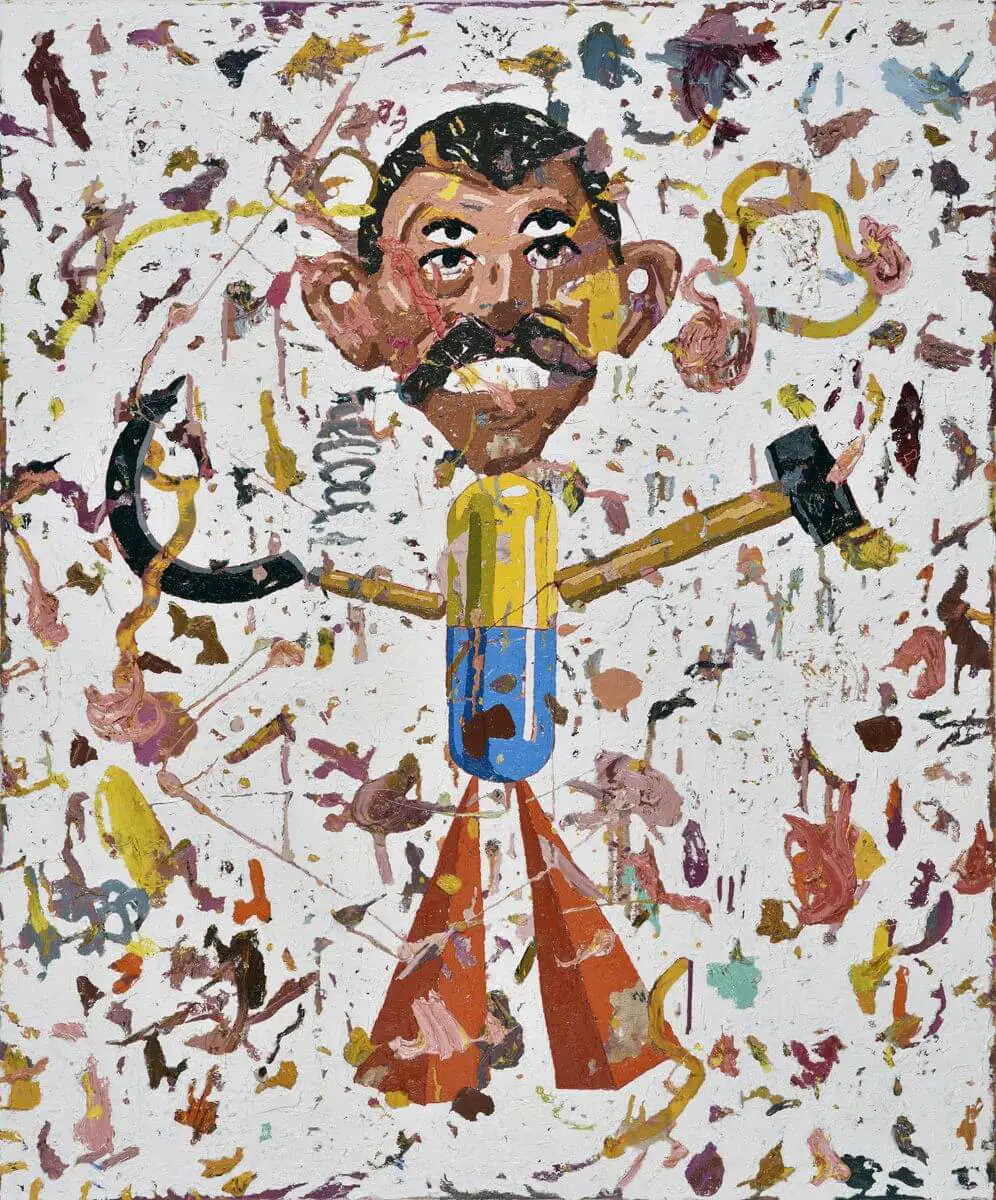
Arjan Pregl, from the Carnival series, oil on canvas (6 paintings 120 x 100 cm; 3 paintings 80 x 60 cm), 2018. www.mg-lj.si
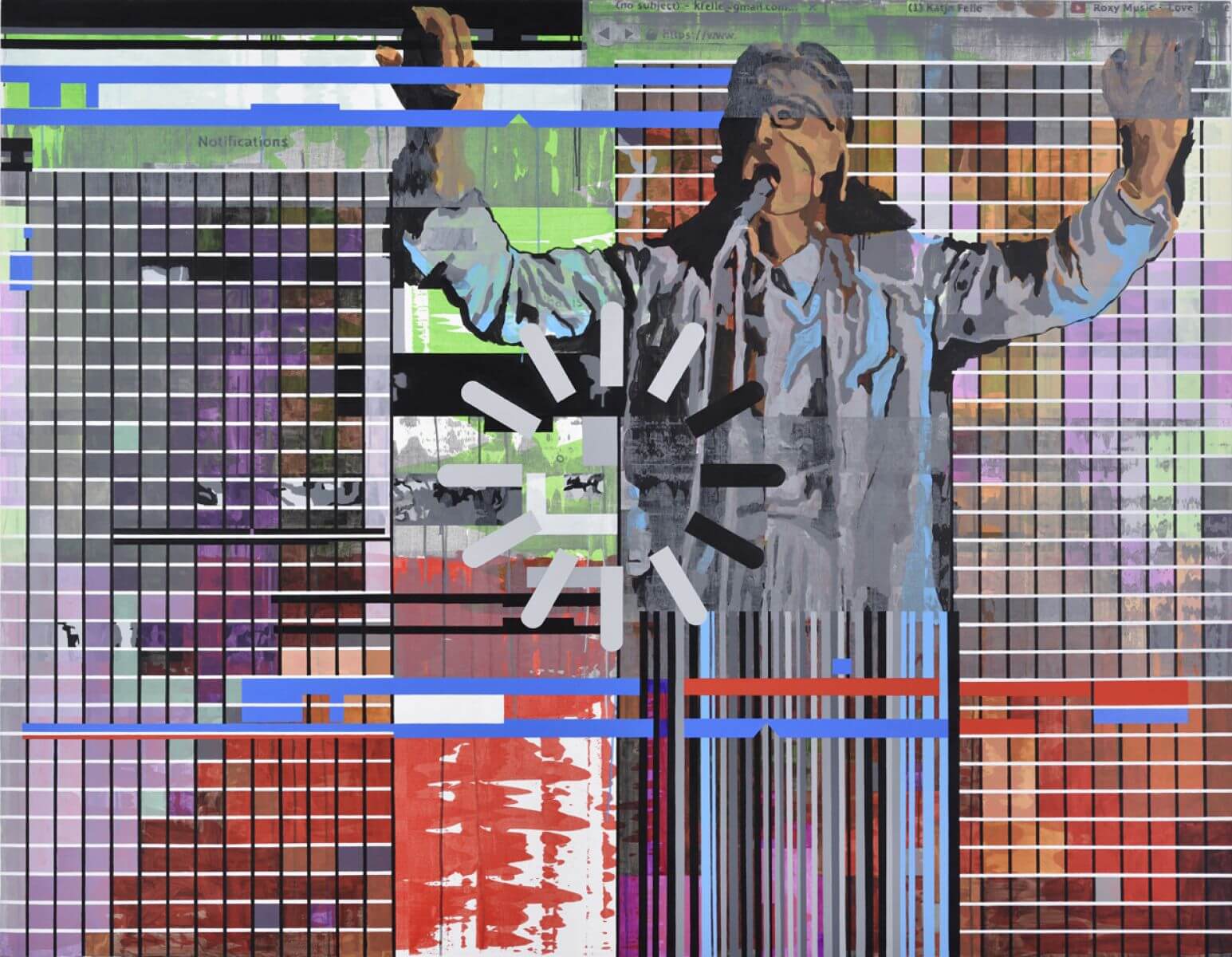
Katja Felle, No. 10, 2015, acrylic on canvas, 170 cm x 220 cm. www.mg-lj.si
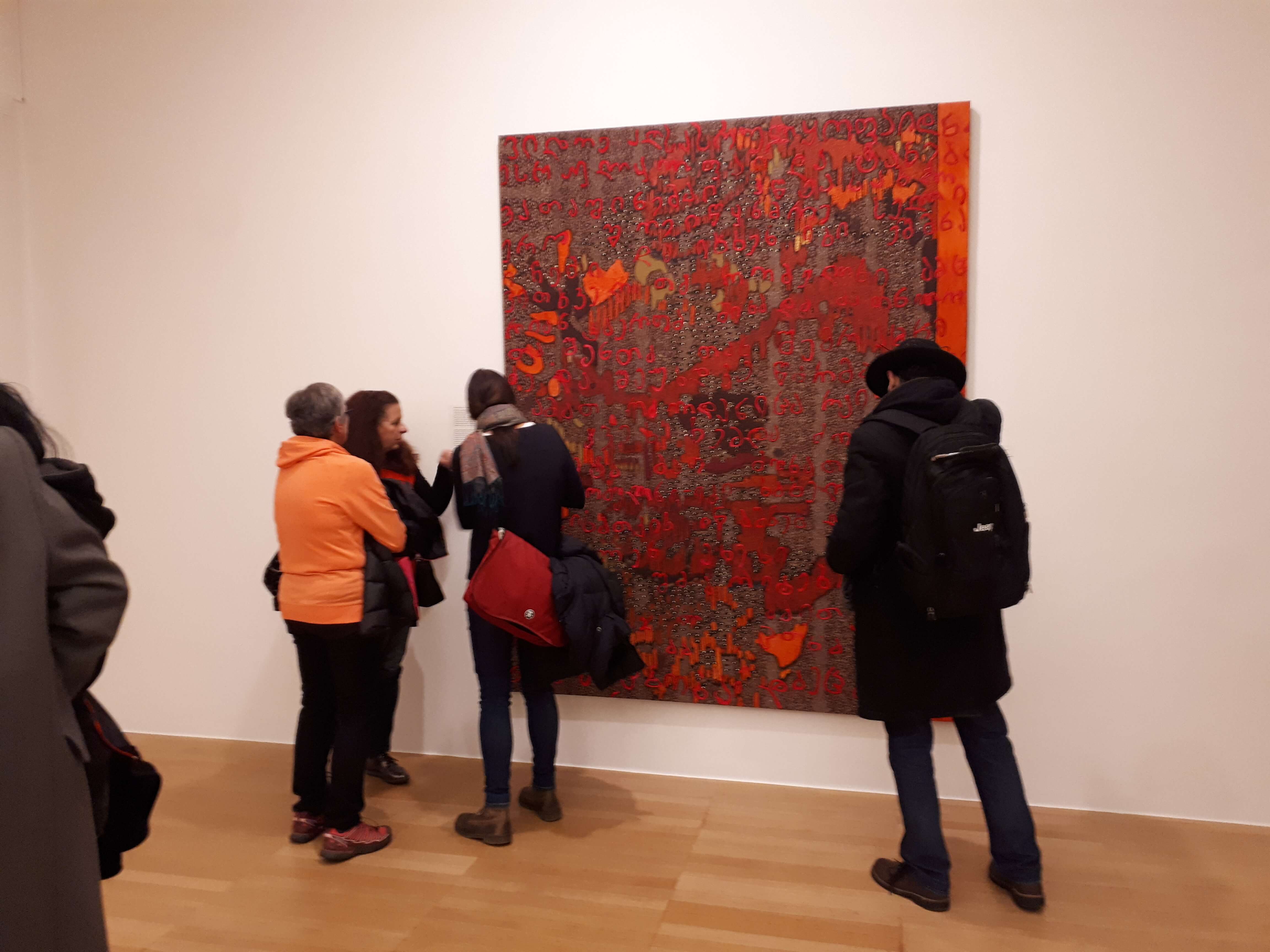
Photo: JL Flanner
We visited on opening night expecting a good party, and were delighted to find that in addition to the beautiful people smoking outside and free wine in the basement the paintings themselves were really good, so much so that we took them in twice before heading down for something to drink.
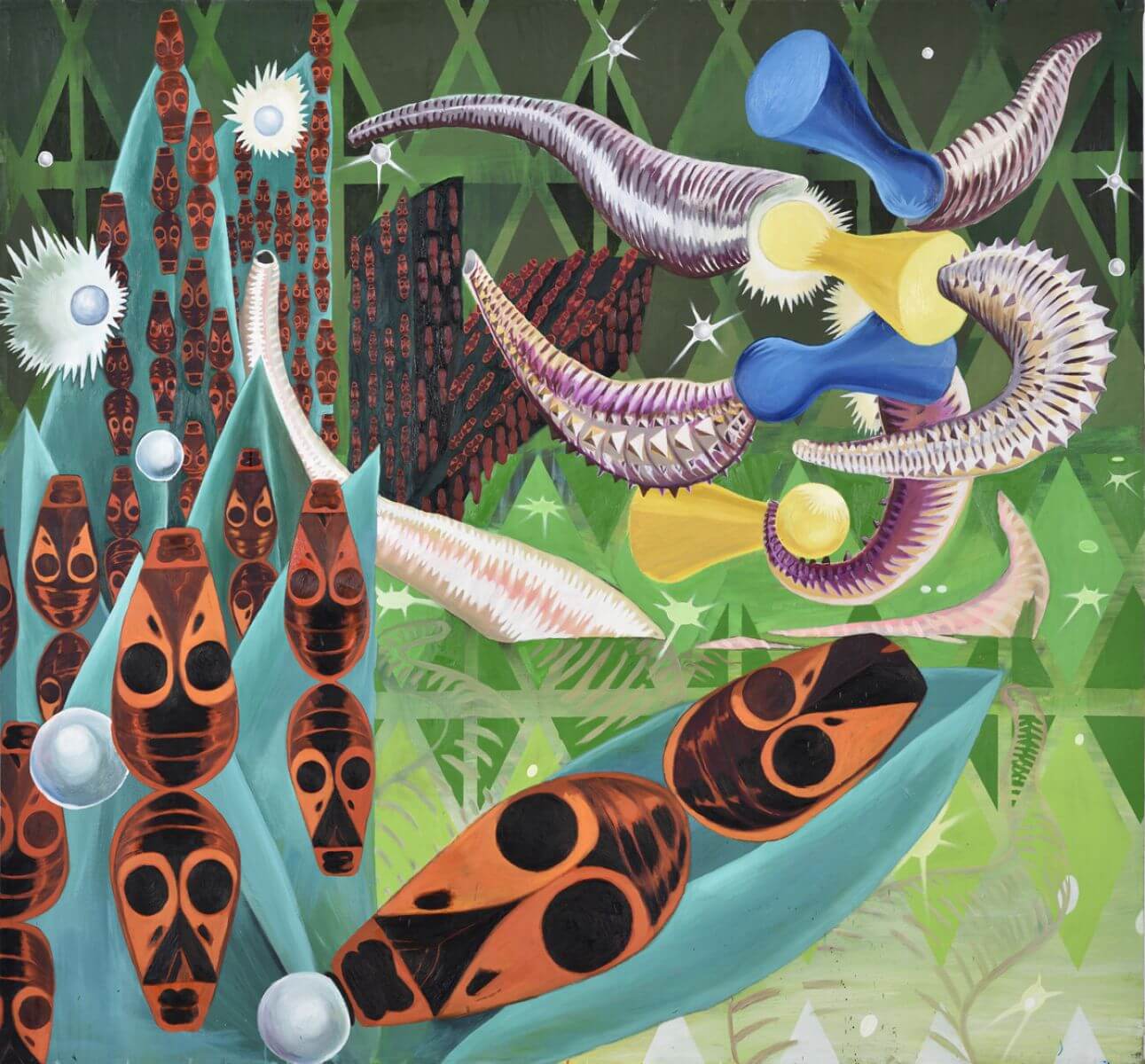
Iva Tratnik, Mating Season Totalitarianism, 2014, oil on canvas, 210 x 194 cm. www.mg-lj.si
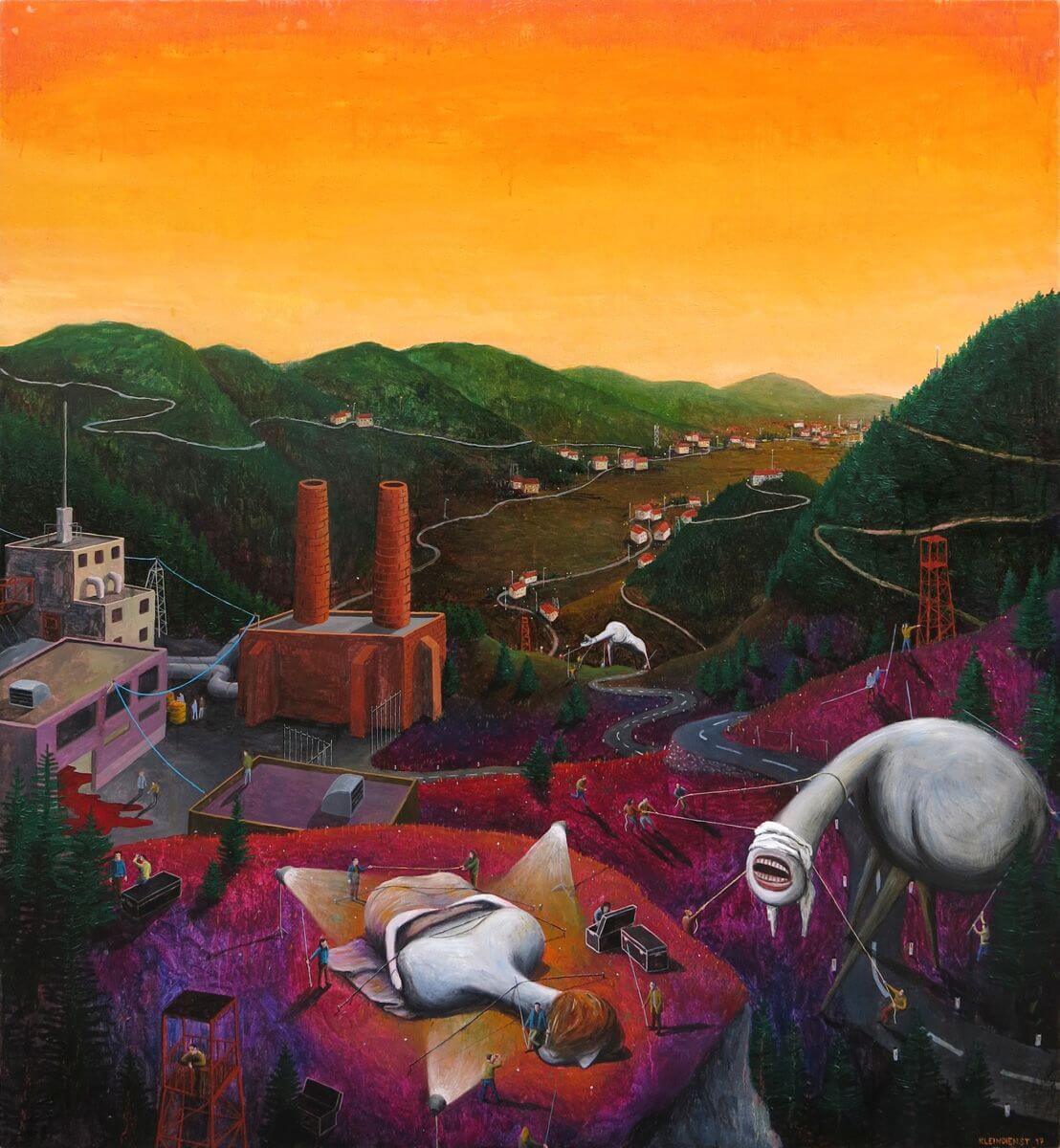
Staš Kleindienst, The triumph of darkness, 2017, oil on canvas, 120 x 130 cm. www.mg-lj.si
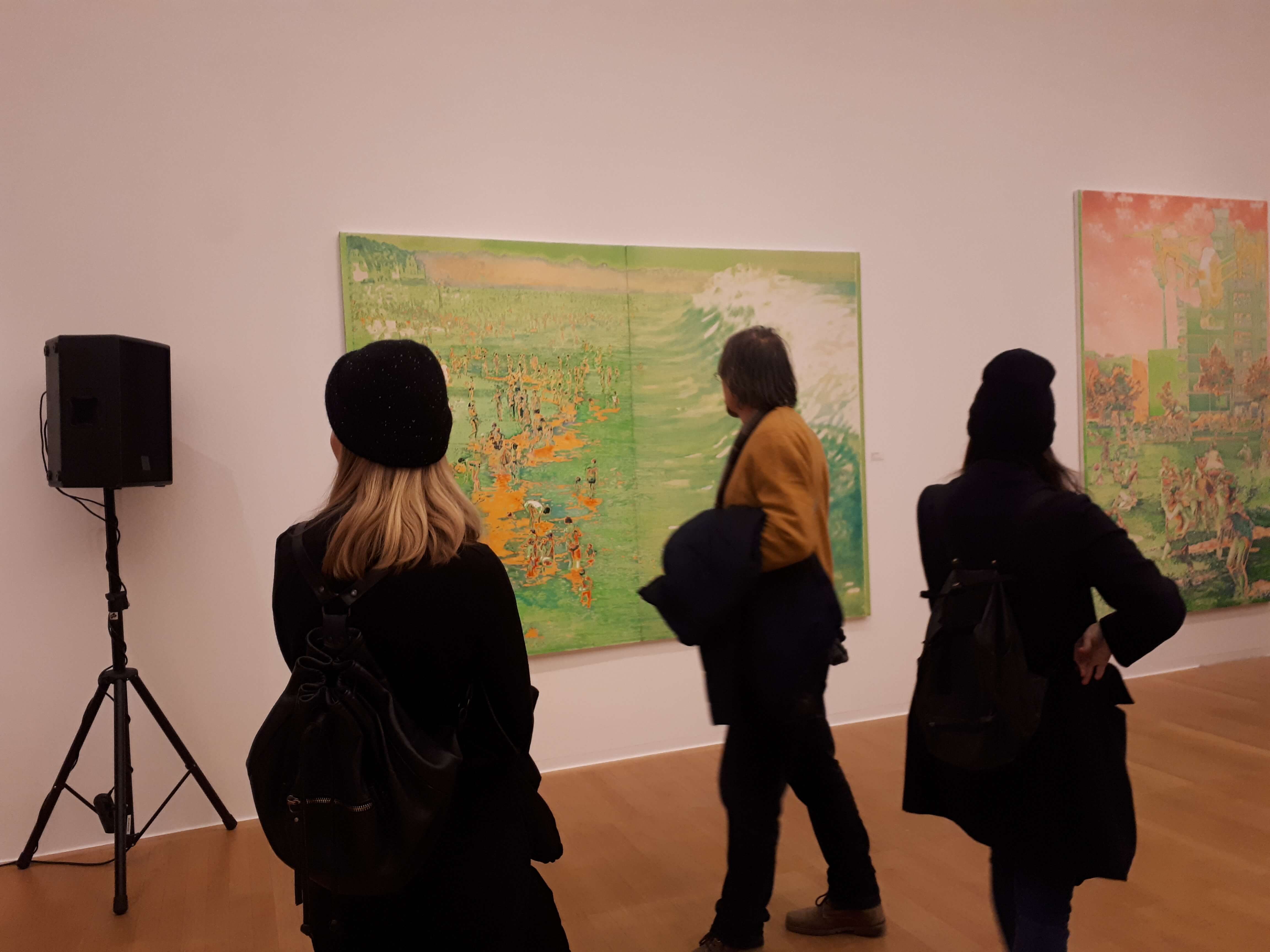
Photo: JL Flanner
The Moderna’s website has more high quality pictures of the works on display, but I’m also adding some from the opening so you get an idea of the scale of things. It was this size that impressed, as well as the real craft on display, but what got me raving about it the rest of the evening were the colours, the humour and beauty, how much pleasure was to be had there. These were nice pictures that I enjoyed looking at, and which I’ll come back and look at again.
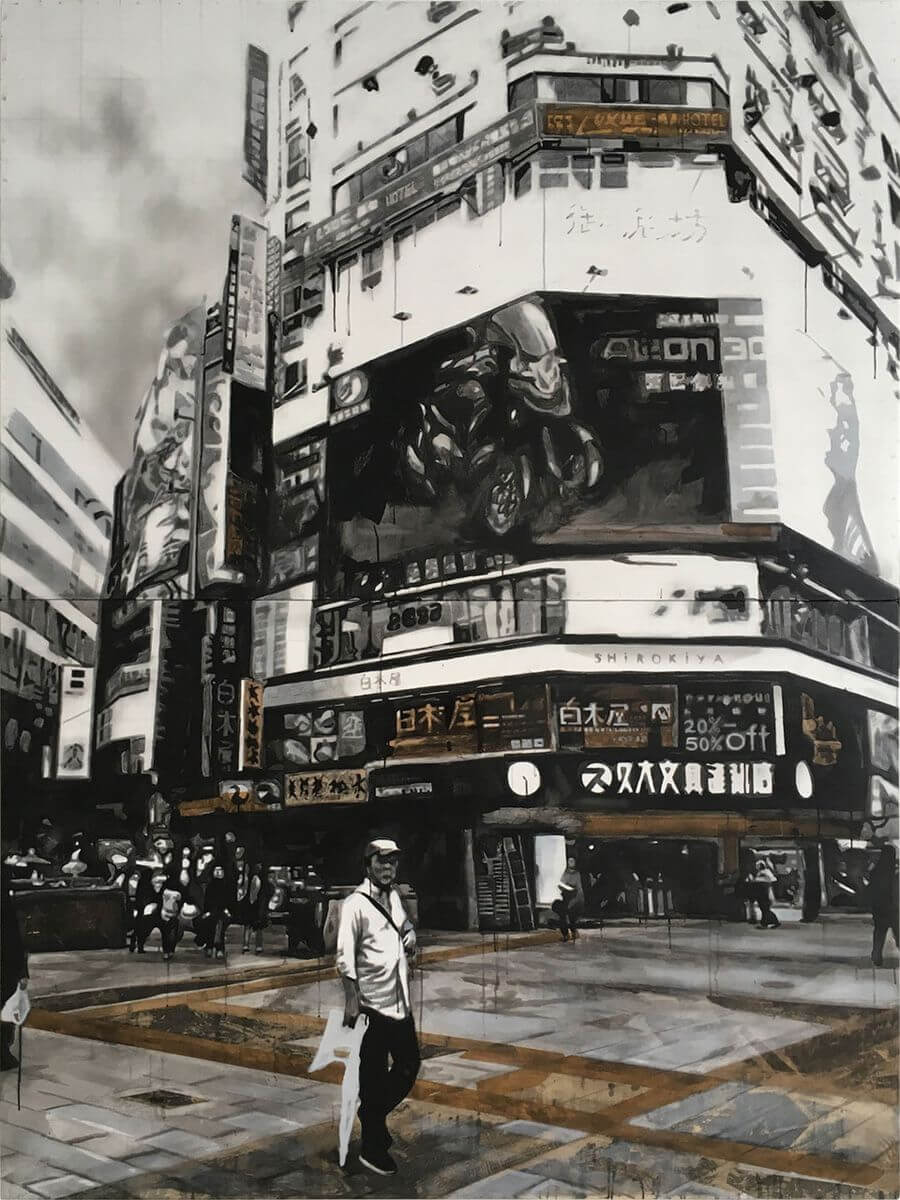
Miha Štrukelj, Shopping District, 2016, acrylic, ink, charcoal, pencil, crêpe paper on canvas, 300 x 225 cm. www.mg-lj.si
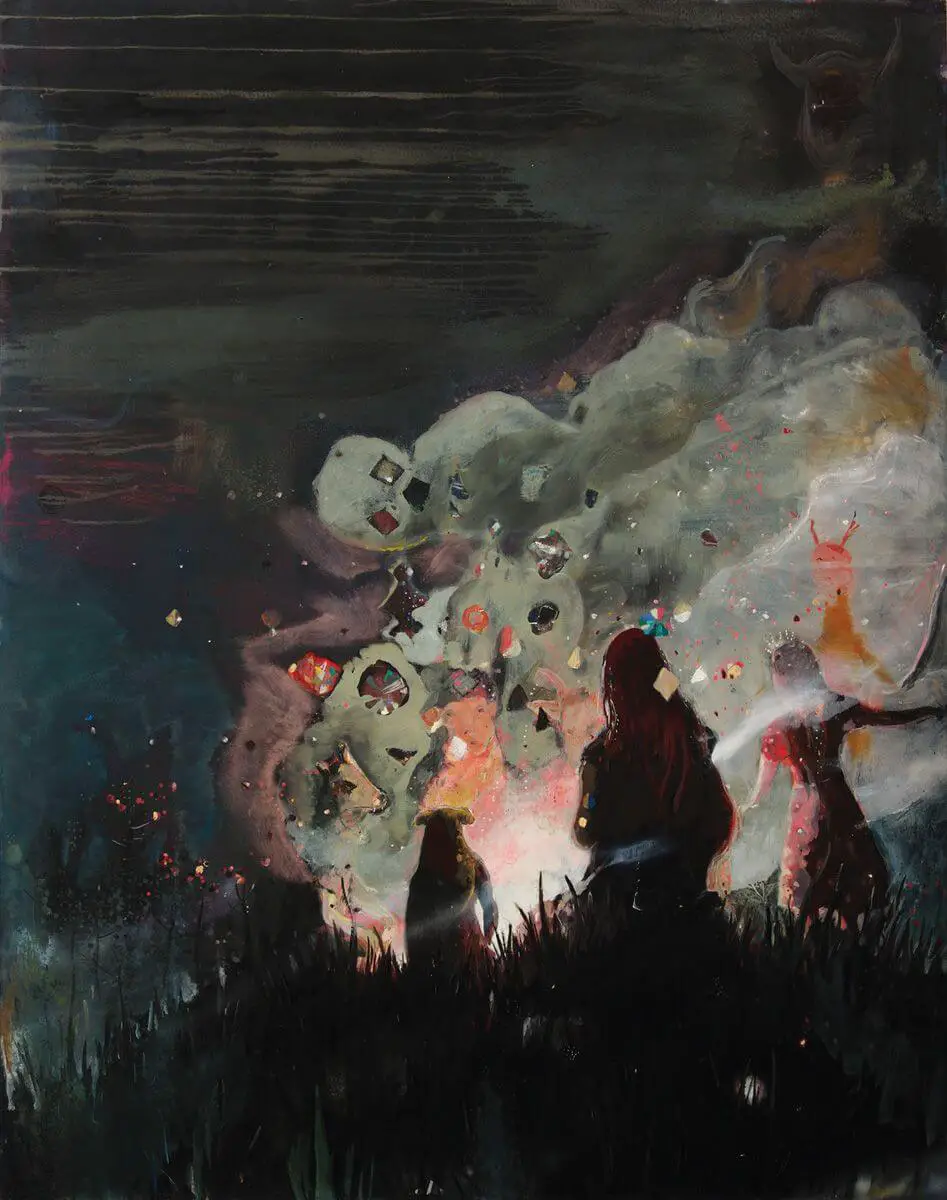
Mitja Ficko, Midnight school, 2012-2016, oil on canvas, 200 x 160 cm. www.mg-lj.si
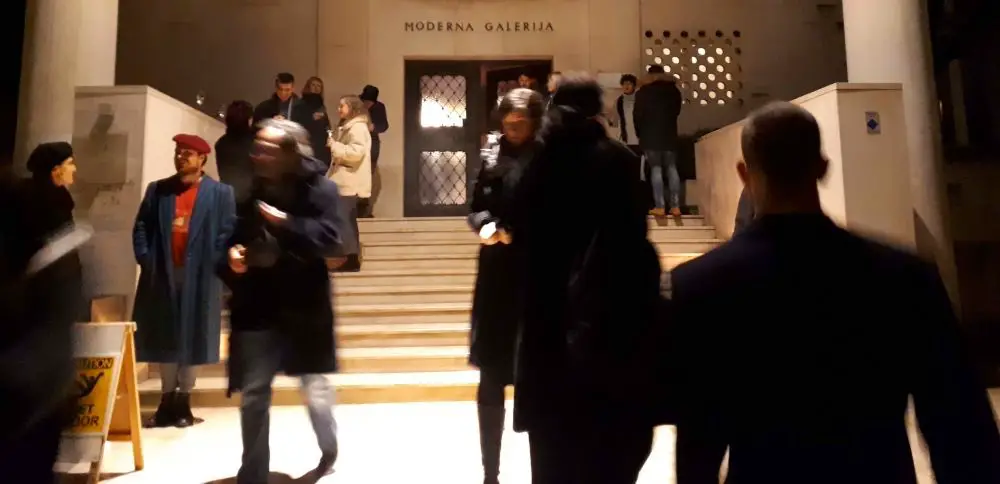
Photo: JL Flanner
Curated by Martina Vovk, the show is a mix of varied delights with multiple works from Viktor Bernik, Suzana Brborović, Gašper Capuder, Ksenija Čerče, Nina Čelhar, Tina Dobrajc, Katja Felle, Mitja Ficko, Mito Gegič, Žiga Kariž, Staš Kleindienst, Vladimir Leben z Ercigoj Art, Uroš Potočnik, Adrijan Praznik, Arjan Pregl, Ana Sluga, Miha Štrukelj, Maruša Šuštar, Iva Tratnik, Sašo Vrabič, Joni Zakonjšek, Marko Zorović and Uroš Weinberger.
You can find the Moderna Galerija at Cankarjeva 15, 1000 Ljubljana, and it’s open from 10:00 to 18: 00, Tuesday to Sunday, and closed Mondays. If you’re in the neighbourhood then be aware that the National Gallery (Narodna galerijaI) and National Museum (Narodna Muzej) are nearby, while if you venture into Tivoli Park you can find the International Centre of Graphic Arts (Mednarodni grafični likovni center).
If you live in Slovenia and don’t speak the language then at various times you’re going to need the services of a translator, and no matter what your abilities you’ll occasionally need a certified translation of an official document. On the other side of things, as a non-Slovene a common form of employment here, self or otherwise, will draw on your abilities with your mother tongue.
In short, translations, translators and translation agencies are an unavoidable part of life for individuals and firms operating in and out the country, and a subject of professional curiosity for many non-Slovene residents.
It was thus with great interest that I met with Dejan Šušnik, one of the founders of Amidas, the first private translation agency in the country, established just after Slovenia declared independence. Curious as to how the industry had changed over the last three decades, and the shape it’s in now, I sat down with Mr Šušnik for the following interview.
How did you get started in translating?
My father worked for Yugotours, a well-known Yugoslav tourist agency first founded in London, Oxford street and then later in New York. Because of my father’s work in London and later New York I grew up bilingual. In fact my brother and I spoke to each other in English for some while after we came back to Slovenia. That’s how I started translating, although just Slovene into English at the time.
How did Amidas start?
The idea for the company was mine. At the time I worked as a librarian at the Jožef Stefan Institute, finally as chief librarian. During this time I started getting work as a translator, the translation work started piling and I had to make a decision, either to translate or to stop working at the Institute. Since I preferred to be my own boss, I quit my job at IJS.
Just before the war [in 1991] I was, among other things, asked to organise the news service for the Slovenian government, so I set up a team translating the news from Slovene to English. I was the person translating the news when the war began, which I announced to the media. Then with Slovenia’s independence it became possible to open a private business, and that’s how we became the first translation company to open in the country.
I should note though that I didn’t start Amidas myself, but with two friends. One took care of the organisation, I did the marketing and translating, and then we got an Englishman for the language editing and the image – Roger Metcalfe, who was actually involved with translating some of the Slovenian constitution.
What’s changed since the early days?
The technology, most of all. At first, in the 80s, I was using a typewriter and sending documents by courier. Then in the early 90s we started to get a bit of email, but we still had to use paper dictionaries and there were no translation tools. But then those started coming onto the Slovenian market, a few years after some other countries, and of course they’ve only improved, along with the number of computers we use. This has made both translating and organising translating much easier.
Another change is that I thought there’d be more translation into English than Slovene, and that was true at the beginning, but then we started to get more and more foreign companies who needed things translated into Slovene. We started working with for Nokia, for example, who also gave us some new translation tools to work with. And then around 2000 there was Microsoft and Windows XP. That was a huge volume of work, you have no idea how many words are in a programme, some two million. If you can imagine it, we translated all the interfaces, system messages, error messages and so on, for that version of Windows, some of which are probably still in there.

Some of the team at Amidas
Is your work mainly with large clients?
Yes, we still have some large clients, like Fraport, Telekom Slovenije, Pošta Slovenije, Postojnska jama and so on, and the work is quite varied. For example, for the Bank of Slovenia we translate their reports into English, while we translate from English into Slovene for the European Central Bank, and we do quite a lot of work for the EU.
That said, we also work on smaller projects, even with individuals, so certified translations for marriages, passports, that kind of thing.
I noticed that you’re very well organised in terms of project management. How important is that for the business?
Project management is key, especially when the business starts growing. The managers know, based on the subject matter, where to send each text. So if it’s nuclear physics or art history it’ll go to the right person. This kind of organisation might be quite common outside of Slovenia, but it’s still rare here, and those companies that do try and do it better tend to follow what we do, rather than something different.
But if I had to say why we’re so well organised, other than our experience, then I think it might be because we’re members of some professional organisations, such as European Language Industry Association (ELIA), Gala and Eulogia. We were actually one of the founding members of ELIA, and it started because the other translation organisations just didn’t seem good enough. We wanted to start something based on real know-how and knowledge, so that people could learn more about the business. It holds events twice a year now, mainly to make contacts and organise some business-to-business work. But there are also sessions on, let’s say, project management, machine translation, sales, and so on.
So you’re quite well-integrated within the wider industry?
Yes, and that means we’re part of a transnational team that has access to almost all the languages. So, for example, if you need something from Slovene to Swedish we have a reliable partner we know is good at this, and who can meet your deadline.
Is outsourcing important?
Yes. It would be very difficult to find a good translator for, let’s say, English to Japanese or Japanese to English in Slovenia, so for jobs like that we go to our partners in the UK or Japan. What this means in practice is that whatever language pair people come here with we can probably help them, and not just with someone who knows a little Finnish, for example, but an expert. And we can deal with the whole project without the client having to worry about finding someone in Helsinki.
I saw that you also offer desktop publishing, editing and copywriting, are these other services a large part of the business?
Well, editing is always part of translating, and copywriting we don’t do so much of, to be honest. That’s more like localisation and making sure that your message is expressed in a way that’s culturally, and not just linguistically, appropriate.
Desktop publishing is another case, and that’s a growing part of our work. With this the customer just sends us the Adobe inDesign files for, say, a brochure or manual, and we’ll not only translate it but also handle the layout and design, so that the translated version looks as much like the original as possible, sending a file back to that’s ready for publishing
And what’s the future for Amidas?
One thing is we’re looking to expand to other countries, ex-Yugoslavia first. But my involvement is winding down now, and my daughter, Nina, who’s been working here for 20 years, she’s taking over, so you’ll have to come back in two decades and ask her what happened.
If you’re interested in working with Amidas, which is based in Ljubljana but works internationally, you can learn more about the company on its website.
STA, 9 January 2019 - Composer, conductor and jazz musician Urban Koder has died, his family told the STA on Wednesday. Koder was honoured last December with the Silver Order of Merit by President Borut Pahor for leaving a notable mark on Slovenian theatre, film, radio and music.
Koder was a significant figure of the Slovenian cultural landscape, and has left a great mark on the Radio Ljubljana Dance Orchestra, the predecessor of the RTV Slovenija Big Band, said the the big band's conductor Lojze Krajnčan.
"Koder was a member of the first generation of Slovenian jazz musicians and was a pioneer as a trumpet soloist in the then Radio Ljubljana Dance Orchestra and as a long-term member of the Ljubljana Jazz Ensemble," Krajnčan said.
According to him, Koder was one of the first Slovenian jazz soloists and improvisers.
The editor for jazz music at Radio Slovenia and former art director of Big Band Hugo Šekoranja agrees that Koder was a big name in the Slovenian culture sphere.
"Despite being a doctor and the prospects of a respectable career in medicine, he listened to his heart and followed his musical muse, first as a trumpet player and then as a composer. This was definitely the right decision, because Koder is one of the most unique artists in Slovenian music history," he told the STA.
Koder was foremost an intellectual and this very much reflected in the broadness of his music work, Šekoranja added.
Born in Ljubljana, Koder turned 90 in March. He studied medicine and worked as a doctor. He joined his first music band when he was thirteen and then played the trumpet in the Dance Orchestra a few years later in 1945.
He conducted the Ljubljana Jazz Ensemble when it made the first jazz record in post-war Yugoslavia and was one of the founders of the Yugoslav Jazz Festival and later also the Ljubljana Jazz Festival.
He collaborated with music giants like Henry Mancini and Luis Armstrong and all top musicians of the region.
He wrote countless pieces of music, including some 100 chansons and music for children's theatre and radio plays. He made music for 20 feature films, four documentaries, ten TV series and 15 short animated films.
His best known work is the music for Matjaž Klopčič's 1973 cult film Cvetje v Jeseni (Blossoms in Autumn). "If Urban Koder wrote nothing but the music for Blossoms in Autumn he would have still been listed among the giants of Slovenian music," the president's office said when presenting him with the Silver Order of Merit in mid-December.
Krajnčan said that he managed to "brilliantly capture the Slovenian soul in the simple melody for the zither."
In 1992, Koder received the Fran Milčinski - Ježek Award conferred by the public broadcaster RTV Slovenia for special radio and television achievements.
STA, 7 January 2019 - US First Lady Melania Trump tops the list of the 100 most influential Slovenians compiled by the right-leaning magazine Reporter, followed by UEFA president Aleksander Čeferin, and the three most influential politicians - Prime Minister Marjan Šarec, President Borut Pahor and parliamentary Speaker Dejan Židan.
The top five are followed by Slovenia's first President Milan Kučan, former boss of pharma company Lek Mojmir Urlep, now a state secretary in the prime minister's office.
The top ten are rounded off by Stojan Petrič of the Idrija-based industrial conglomerate Kolektor, Gregor Golobič, the founder of the now defunct Zares party and aide to late Slovenian leader Janez Drnovšek, and the head of the opposition Democrats (SDS) Janez Janša.
After Melania Trump, the most influential Slovenian woman is Alenka Bratušek, Slovenia's first female prime minister who now serves as the infrastructure minister in the minority government of Marjan Šarec and leads the party bearing her name.
The only athlete on the list is the teen basketball sensation Luka Dončić of the Dallas Mavericks of the NBA, who rounds off the entire list in 100th place.
In an accompanying commentary, editor-in-chief Silvester Šurla notes that there are only 15 persons who found themselves on the list of 100 most influential Slovenians compiled by Mag, the predecessor of Reporter, twenty years ago.
In 1998, the second most influential Slovenian was Kučan, who was still the head of state then. Kučan, who ended his presidency in 2002, is still very high on this year's list, in sixth spot.
Kučan is still among the top ten but his influence has diminished somewhat since, but he still has a strong informal influence, also maintained through his left-leaning Forum 21 organisation.
Šurla says that Forum 21 is a network built around the former Communist Party and its younger supporters which has survived three decades of transition. Kučan will soon celebrate his 78th birthday, but he is still very active, Šurla says.
The most influential politicians are unsuprisingly the prime minister, president and parliamentary speaker, who have a strong formal influence by default, regardless of who actually holds the post.
Although he is a political novice, Prime Minister Marjan Šarec is the most influential politician, who has the opportunity to increase influence on a daily basis in addition to gaining political experience, Šurla says.
Although he has not been at the helm of the government since 2013, the head of the opposition Democrats (SDS) Janez Janša remains rather influential, rounding off the top ten.
The fact that Janša is not able to form a government despite being relative election winner diminishes his political power, while he is still trying to keep the role of political hegemon right from the centre, the commentator says.
The most influential business executive is Petrič, who is not only controlling a group which includes the newspaper publisher Delo, he is also quite wealthy and his informal connections lead to the very top of Slovenian politics.
The top two persons on the list are nevertheless Slovenians who are influential on the global and European scale, Šurla notes
The influence of Melania Trump at the global level is incomparably stronger than of any politician or business executive in her native country, as she can have a considerable influence on the decisions by President Donald Trump.
Since football is still the most popular sport in the world, right behind Melania Trump is Aleksander Čeferin, the president of the Union of European Football Associations (UEFA).
Speaking about the importance and influence of the post is the fact that the organisation's budget in a four-year term of an UEFA president stands at a whopping EUR 12.3bn.
"Slovenians are actually not very well aware yet how important posts these two compatriots hold," Šurla finds.




